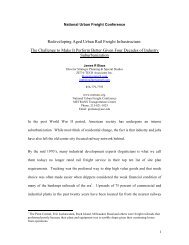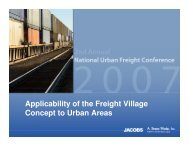Table of Tables - METRANS Transportation Center
Table of Tables - METRANS Transportation Center
Table of Tables - METRANS Transportation Center
Create successful ePaper yourself
Turn your PDF publications into a flip-book with our unique Google optimized e-Paper software.
Evaluating the Feasibility <strong>of</strong> Electrified Rail at the<br />
Port <strong>of</strong> LA/LB<br />
<strong>Table</strong> 3 summerizes those detailed estimates <strong>of</strong> overhead caternary distribution cost for<br />
556 Single track Kilometers (STK) or 173 doubl e track miles, to allow comparison with<br />
previous data. The cost <strong>of</strong> $127M CD for 556 STK converts to $692k/mile in 2008 USD.<br />
6 Conclusions and Recommendations<br />
Information from S ections 5.1, 5.2, a nd 5.4 i ndicate t he cost <strong>of</strong> double t rack retr<strong>of</strong>it<br />
electrification <strong>of</strong> rail ranges from $1.42M to $1.5M per mile for third rail and $.825M to<br />
$1.5M per mile for ove rhead c aternary. T hese a re onl y the capital costs for providing<br />
power t o a l ocomotive on e xisting r ight-<strong>of</strong>-way. S ince t hese cos ts w ere de rived from<br />
passenger systems, use <strong>of</strong> longer and heavier freight trains at the Port will likely require<br />
more power for more tractive effort, and hence the distribution costs <strong>of</strong> these estimates<br />
could be somewhat higher.<br />
Neither at -grade t hird r ail nor ove rhead c aternary are conducive t o t rain f ormation<br />
involving l oading, unl oading, a nd num erous s hort s witched s idings. H owever,<br />
operational r equirements s uch a s witching a nd pow er r equirements favor ov erhead<br />
caternary, making it the better approach for hauling train sections or shuttle trains from<br />
the port to Diesel pulled transcontinental train intermodals. Even with block switching <strong>of</strong><br />
at-ground t hird rail–applying pow er onl y t o s egments us ed b y t he l ocomotive, t his<br />
approach f or rail r etr<strong>of</strong>it e lectrification i s de emed t oo da ngerous. T hus, ove rhead<br />
caternary s eems t he m ore ope rationally realistic and safest appr oach to retr<strong>of</strong>it r ail<br />
electrification for movi ng t rains f rom te rminals to ICTF, SCIG, or along t he A lameda<br />
Corridor.<br />
An important issue concerning feasibility, however, is the intended operating process <strong>of</strong><br />
the electrified rail. With the cost <strong>of</strong> modern hybrid locomotives capable <strong>of</strong> operating on<br />
electrified tracks running from $2.5M to $5M each (Appendix D) (on the order <strong>of</strong> worst<br />
case cost <strong>of</strong> retr<strong>of</strong>it electrification per mile), the number and cost <strong>of</strong> the locomotives for a<br />
operating scenario will be the major factor in electrification cost for short haul distances.<br />
The Alameda Corridor is a dedicated freight rail corridor running 22 mi directly between<br />
the Ports <strong>of</strong> Los Angeles and Long Beach and the Redondo Junction, near the major rail<br />
yards just east <strong>of</strong> downtown Los Angeles. The corridor currently carries more than 50<br />
trains per day. If overhead caternary retr<strong>of</strong>it is possible or third rail retr<strong>of</strong>it required for<br />
vertical clearance issues, a very rough estimate <strong>of</strong> retr<strong>of</strong>it electrification to the three track<br />
corridor might be $45M. A t this juncture an estimate requires an assumption as to the<br />
power a nd num ber <strong>of</strong> required l ocomotives. S huttle t rains w ould be m ore num erous<br />
than long transcontinental trains and locomotives dedicated to operating on the corridor<br />
could make mul tiple r ound trips pe r da y; limiting the num ber <strong>of</strong> existing dual-mode<br />
electro-Diesel locomotives engines to an optimistic number <strong>of</strong> 150 (50 pull teams <strong>of</strong> 3<br />
engines (Figure 8), each making 3 r ound trips per day and moving the equivalent <strong>of</strong> 50<br />
transcontinental tr ains) for a c ost <strong>of</strong> $300M . The tot al inf rastructure investment f or<br />
electrifying the Alameda Corridor would be $345M providing a shuttle train scenario was<br />
realistic. This is in line with a prior SCAG study (1992) with adjusted cost estimate <strong>of</strong><br />
21




